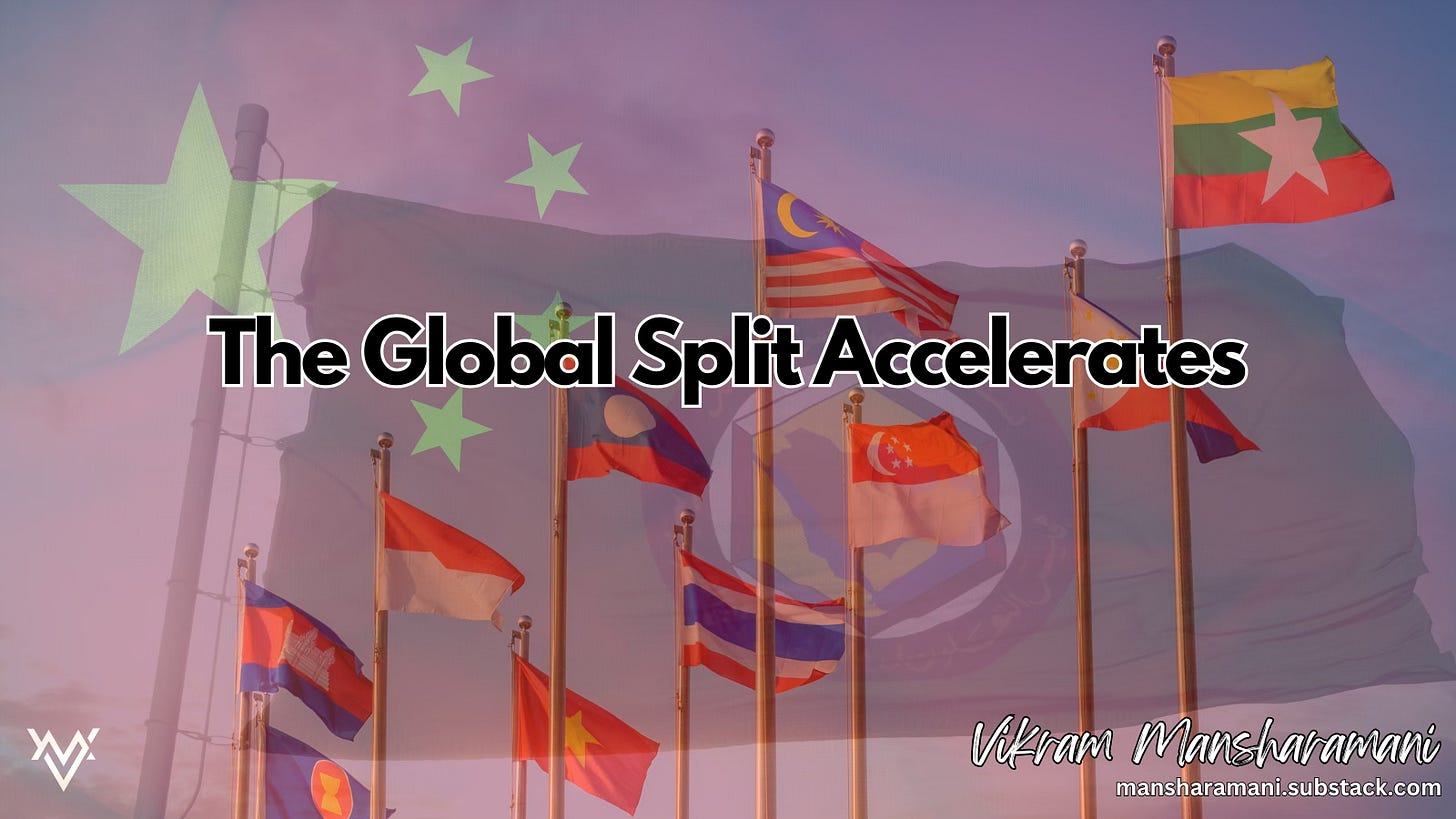I have long been thought the world is in the process of bifurcating into two economic ecosystems, one led by America and the other by China. As is now obvious to the world, the split is accelerating as China’s global ambition runs headlong into President Trump’s 21st century version of the Monroe Doctrine that is best thought of as the Americas First movement. The United States is clearly focused on partnering with neighbors in the Western Hemisphere and providing notice to the Chinese and other foreign powers that North and South America are off-limits.
On the other side of the world, however, China is effectively telegraphing to America that Southeast Asia is off limits. Next month, the 46th ASEAN Summit will take place in Malaysia. In addition to the typical symbolic meetings among leaders of ASEAN’s 10 member nations, some new additions suggest the bifurcation is indeed progressing faster than most of us are aware.
Specifically, ASEAN leaders plan to meet with their counterparts from the Gulf Cooperation Council (GCC), a collection of six Middle Eastern countries that have the large reservoirs of energy necessary to power ASEAN growth. Both regions are key economic hubs, Southeast Asia in manufacturing and tech, and the Gulf in energy and finance. In 2023, the GCC and ASEAN held a first-ever summit in Riyadh and next month’s meeting is evidence the ties are strengthening. But how does this all tie to the US-China War?
Well, there’s also a third meeting during the summit that really caught my eye. It’s an ASEAN-GCC meeting that also includes….drumroll please…China.
China is the world's largest energy importer and has long sought stronger ties with the Gulf’s oil-exporting countries. They are seeking to lock in long-term supply deals and to settle more oil trades in yuan rather than dollars. And while that’s been true for years, it’s the ASEAN-GCC-China connection that points to a more serious collaboration…and China’s attempt to de facto create an economic ecosystem from Malaysia to Beijing, and Hong Kong to Riyadh. Think of it as China’s version of the Monroe Doctrine.
China is already ASEAN’s largest trading partner, and it is eager to strengthen the China-ASEAN Free Trade Area (CAFTA). Regional security is also on the agenda, including cooperation on cybersecurity, transnational crime, and disaster response. Addressing disputes in the South China Sea is also a top ASEAN concern, and it hopes to finalize the South China Sea Code of Conduct by 2026.
Nudging the U.S. out of the far Pacific and snapping the petrodollar backbone of the global financial order are key elements of China’s plan to challenge the U.S. role as global superpower. Security agreements, trade deals, direct investment, cultural exchanges and Chinese language programs, the infrastructure projects of the Belt and Road Initiative (BRI), and direct investment have all been means toward this end.
Nudging the U.S. out of the far Pacific and snapping the petrodollar backbone of the global financial order are key elements of China’s plan to challenge the U.S. role as global superpower.
So, how has the U.S. reacted to these moves, especially those involving ASEAN?
The Biden administration was aggressive, seeking to strengthen ties and relations. The U.S. and ASEAN elevated their relationship into a Comprehensive Strategic Partnership, a joint maritime exercise was planned, and USAID launched a five-year partnership program. There was also a flurry of diplomatic activity, with a long line of U.S. officials visiting ASEAN countries, including then-U.S. Secretary of State Anthony Blinken; over the course of the administration, five U.S.-ASEAN Summits were held.
Contrast this with the Trump administration’s approach, which was kicked-off with tariffs that hit the region especially hard; many countries in the bloc were hit with tariffs in excess of 40%. China has sought to take advantage, and Chinese President Xi Jinping recently finished a Southeast Asia tour, presenting China as a reliable and stable partner. Expect President Trump to take a more transactional approach, always asking, “What’s in it for the U.S.?” The right answers will likely involve dollars and cents. Power and influence to counter the Chinese, while necessary, may no longer be a sufficient response to secure US engagement.
Trump’s approach – eschewing foreign entanglements, staying focused on the Americas, limiting reliance on foreign goods and energy - is only going to accelerate the decades-long separation of the world into two systems. As the United States retrenches to the Western Hemisphere, America is increasing focused on keeping foreign influences out of Americas. Countries and corporate leaders alike need to recognize these developments mean they will eventually have to pick a side, especially when it comes to accepting inbound investment and the influence it.
Trade patterns will shift over time and buying from and selling to China won’t follow a linear trend, but the real choice that needs to be made is around investments and the influence granted to investors. These choices are being made right now as corporate boardrooms in America and government leaders in Beijing decide where to invest their capital…and countries choose from whom to seek and accept investments.
As I recently shared with the CEO of one of the world’s largest mining companies, it’s one thing to sell China copper; it’s a completely different thing to sell them the copper mine.”
VIKRAM MANSHARAMANI is an entrepreneur, consultant, scholar, neighbor, husband, father, volunteer, and professional generalist who thinks in multiple-dimensions and looks beyond the short-term. Self-taught to think around corners and connect original dots, he spends his time speaking with global leaders in business, government, academia, and journalism. He’s currently the Chairman and CEO of Goodwell Foods, a manufacturer of private label frozen pizza. LinkedIn has twice listed him as its #1 Top Voice in Money & Finance, and Worth profiled him as one of the 100 Most Powerful People in Global Finance. Vikram earned a PhD From MIT, has taught at Yale and Harvard, and is the author of three books, The Making of a Generalist: An Independent Thinker Finds Unconventional Success in an Uncertain World, Think for Yourself: Restoring Common Sense in an Age of Experts and Artificial Intelligence and Boombustology: Spotting Financial Bubbles Before They Burst. Vikram lives in Lincoln, New Hampshire with his wife and two children, where they can usually be found hiking or skiing.






